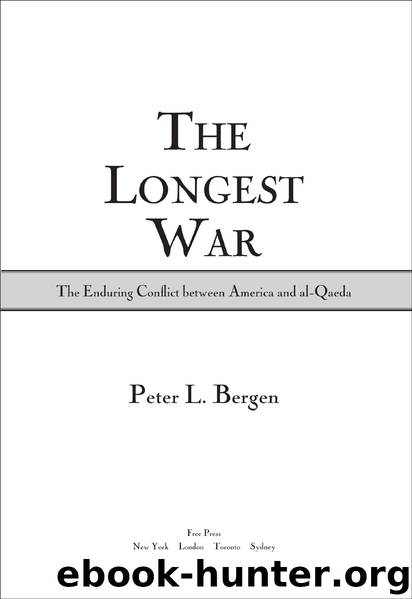The Longest War by Peter L. Bergen

Author:Peter L. Bergen
Language: eng
Format: epub
Publisher: Free Press
Published: 2011-03-25T16:00:00+00:00
Pakistan’s ruler in the years after 9/11 was General Pervez Musharraf. He had come to power following a bloodless military coup in 1999 that ended a decade of civilian rule, which had been characterized by the incompetence and corruption of Pakistan’s elected rulers. For the first years of his tenure as Pakistan’s leader Musharraf was wildly popular, but gradually he managed to alienate much of his country’s population. His first blunder was to rig a 2002 election so that religious parties, in an alliance known as the MMA, did better at the polls than they had ever done in Pakistani history, taking over the North-West Frontier Province. The MMA also did well at the polls in the province of Baluchistan, which is where Mullah Omar, the leader of the Taliban, had fled following the fall of his regime. Under Musharraf’s rule, two out of Pakistan’s four provinces were now largely controlled by the Islamists of the MMA, who were broadly sympathetic to the Taliban and al-Qaeda. The same year Musharraf also held a rigged referendum, boycotted by all the political parties, that extended his power as president for five years, which did much to damage his earlier reputation as a disinterested patriot rather than a power-hungry officer in the mold of other Pakistani military dictators who had preceded him.
On January 12, 2002, Musharraf made an important televised speech to the nation in which he said that Pakistan would no longer tolerate organizations that practiced terrorism in the name of religion. Musharraf banned the militant Kashmiri groups Lashkar-e-Taiba and Jaish-e-Mohammed, both of which had played a role in a gun battle outside the Indian Parliament building in New Delhi a month earlier in which seven guards died. That attack almost brought Pakistan and India to the brink of war again, this time with each side possessing nuclear weapons.
Musharraf’s ratcheting up of the pressure on the militant groups made him the target of their wrath. He survived two serious assassination attempts in December 2003 in the garrison city of Rawalpindi. In the first plot, a cell of Pakistani air force personnel bombed Musharraf’s convoy. In the second attempt, members of Pakistan’s elite commando Special Services Group conspired to kill Musharraf using suicide bombers. While military personnel were integrated into the plots, both assassination attempts were masterminded by al-Qaeda or its close affiliate, Jaish-e-Mohammed. And both attacks came three months after al-Qaeda’s number two, Ayman al-Zawahiri, had for the first time issued a tape specifically calling for attacks on Musharraf because of his cooperation with the United States in the “war on terror.”
A symptom of the increasingly visible and vocal role of the militant Islamists in Pakistan that characterized the latter years of Musharraf’s rule was the standoff between his government and radicals based at the Red Mosque in Islamabad. In the early months of 2007, the militant imam of the Red Mosque, Abdul Rashid Ghazi, was suddenly a force to be reckoned with in Pakistani politics, as his students were staging a series of violent protests.
Download
This site does not store any files on its server. We only index and link to content provided by other sites. Please contact the content providers to delete copyright contents if any and email us, we'll remove relevant links or contents immediately.
| Arms Control | Diplomacy |
| Security | Trades & Tariffs |
| Treaties | African |
| Asian | Australian & Oceanian |
| Canadian | Caribbean & Latin American |
| European | Middle Eastern |
| Russian & Former Soviet Union |
The Secret History by Donna Tartt(18939)
The Social Justice Warrior Handbook by Lisa De Pasquale(12164)
Thirteen Reasons Why by Jay Asher(8837)
This Is How You Lose Her by Junot Diaz(6830)
Weapons of Math Destruction by Cathy O'Neil(6206)
Zero to One by Peter Thiel(5729)
Beartown by Fredrik Backman(5668)
The Myth of the Strong Leader by Archie Brown(5456)
The Fire Next Time by James Baldwin(5379)
How Democracies Die by Steven Levitsky & Daniel Ziblatt(5168)
Promise Me, Dad by Joe Biden(5111)
Stone's Rules by Roger Stone(5051)
A Higher Loyalty: Truth, Lies, and Leadership by James Comey(4904)
100 Deadly Skills by Clint Emerson(4876)
Rise and Kill First by Ronen Bergman(4739)
Secrecy World by Jake Bernstein(4698)
The David Icke Guide to the Global Conspiracy (and how to end it) by David Icke(4654)
The Farm by Tom Rob Smith(4463)
The Doomsday Machine by Daniel Ellsberg(4446)
